Nonlinear Characterization of Acoustic Resonators
by Kilian Förner and Wolfgang Polifke
Motivation
Combustion systems like rocket combustion chambers or gas turbines are prone to thermoacoustic instabilities. Such instabilities occur due to a feedback between the unsteady heat release of the combustion process and the acoustic field within the combustion chamber. The use of acoustic resonators – as shown in Fig. 1 for a rocket thrust chamber – is common practice to increase the stability margins. These resonators dissipate acoustic energy predominantly in small frequency ranges around their eigenfrequencies and, thus, have to be tuned according to the oscillation modes of the combustion chamber. The dissipation mechanisms differ significantly, depending on the sound pressure level (SPL). At low SPLs, this process is dominated by thermo-viscous dissipation, which is a linear effect, i.e., independent of perturbation amplitude. Increasing the excitation amplitudes additionally leads to flow separation at the edges of the resonator, which converts the irrotational acoustic into a hydrodynamic, rotational motion. The vortices formed remain laminar for moderate excitation levels and turn fully turbulent for yet larger levels. This effect is strongly nonlinear and increases the dissipation considerably.
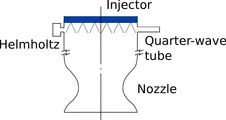
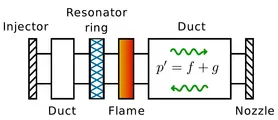
Objectives and Strategy
The influence of the SPL on the damping behavior of resonators is studied systematically using the CFD/SI approach. For that purpose, computational fluid dynamics (CFD) simulations of resonators are performed using broadband excitation signals. Both the laminar and the turbulent regimes are included in this study. On the gained input-output data, system identification (SI) methods are applied in order to achieve a precise model of this process. To estimate the influence on the damping behavior of resonator rings as well as their impact on the overall stability of a rocket combustion chamber, the interaction of both the driving and the damping mechanisms must be considered. For this purpose, a representative rocket thrust chamber characterized by a network of low order acoustic elements is used, see Fig. 2. In addtion to pure longitudinal modes, this network model is also capable of analyzing modes with tangential and radial proportion.
Results
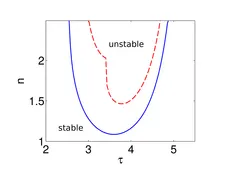
The network modeling clearly shows the stabilizing impact of a well-tuned resonator ring. Exemplarily, Fig. 3 shows the stability margins for a n-τ flame model for a generic chamber without and with ring. For more details, see [1].
The application of the SI method provides the linear behavior over the whole frequency range of interest with a single broadband simulation with high precision, see [2]. Some CFD snapshots depicting the amplitude dependent separation are collected in Fig. 4. Harmonic simulations in the nonlinear regime fit reasonable to experiments. This enables to study the separation process in detail: The separation and accordingly the acoustic resistance can be reduced significantly by chamfering the edges, see [3]. A video for a simulation with chamfered edges is provided below.

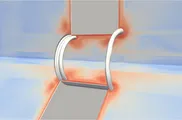
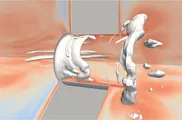
Selected Publications
[1] Förner, K.; Cárdenas Miranda, A.; Polifke, W.: Mapping the Influence of Acoustic Resonators on Rocket Engine Combustion Stability. Journal of Propulsion and Power; available online, 2015, http://dx.doi.org/10.2514/1.B35660
[2] Förner, K.; Polifke, W.; Aero-Acoustic Characterization of Helmholtz Resonators in the Linear Regime with System Identification, 22nd International Congress on Sound and Vibration (ICSV22), Florence, Italy, 2015.
[3] Förner, K.; Temiz, M. A.; Polifke, W., Lopez Arteaga, I.; Hirschberg, A.: On the Non-Linear Influence of the Edge Geometry on Vortex Shedding in Helmholtz Resonators, 22nd International Congress on Sound and Vibration (ICSV22), Florence, Italy, 2015.
Acknowlegment

Financial support has been provided by the German Research Foundation (DFG) in theframework of the DFG TRR40, whose support is gratefully acknowledged.